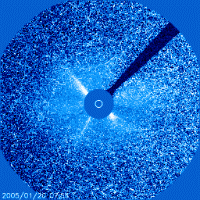|
Going to the Moon? Be careful. A new
kind of solar storm can take you by surprise.
by Dr Tony Phillips
January 2005 was a
stormy month - in space. With little warning, a giant spot materialized
on the sun and started exploding. Between January 15th and 19th,
sunspot 720 produced four powerful solar flares. When it exploded
a fifth time on January 20th, onlookers were not surprised.
They should have been.
Researchers realize now that the January 20th blast was something
special. It has shaken the foundations of space weather theory and,
possibly, changed the way astronauts are going to operate when they
return to the Moon.
Sunspot 720 unleashed
a new kind of solar storm.

more
The
Jan. 20th proton storm photographed from space by the
Solar and Heliospheric Observatory (SOHO). The many speckles
are solar protons striking the spacecraft's digital camera.
|
Scant minutes after
the January 20th flare, a swarm of high-speed protons surrounded
Earth and the Moon. Thirty minutes later, the most intense proton
storm in decades was underway.
"We've been hit
by strong proton storms before, but [never so quickly]," says
solar physicist Robert Lin of UC Berkeley. "Proton storms normally
develop hours or even days after a flare." This one
began in minutes.
Proton storms cause
all kinds of problems. They interfere with ham radio communications.
They zap satellites, causing short circuits and computer reboots.
Worst of all, they can penetrate the skin of space suits and make
astronauts feel sick.
"An astronaut
on the Moon, caught outdoors on January 20th, would have had almost
no time to dash for shelter," says Lin. The storm came fast
and "hard," with proton energies exceeding 100 million
electron volts. These are the kind of high-energy particles that
can do damage to human cells and tissue.
"The last time
we saw a storm like this was in February 1956." The details
of that event are uncertain, though, because it happened before
the Space Age. "There were no satellites watching the sun."
According to space
weather theory - soon to be revised - this is how a proton storm develops:
It begins with an explosion,
usually above a sunspot. Sunspots are places where strong magnetic
fields poke through the surface of the Sun. For reasons no one completely
understands, these fields can become unstable and explode, unleashing
as much energy as 10 billion hydrogen bombs.
From Earth we see a
flash of light and X-rays. This is the "solar flare,"
and it's the first sign that an explosion has occurred. Light from
the flare reaches Earth in only 8 minutes.
Next, if the explosion
is powerful enough, a billion-ton cloud of gas billows away from
the blast site. This is the coronal mass ejection or "CME."
CMEs are relatively slow. Even the fastest ones, traveling one to
two thousand km/s, take a day or so to reach Earth. You know a CME
has just arrived when you see auroras in the sky.

Photographed by Jack
Newton
Sunspot
720 erupting on Jan. 15th 2005
|
En route to Earth,
CMEs plow through a lot of gaseous material, first in the sun's
atmosphere and then out in interplanetary space. You thought space
was empty? No. The void between planets is filled with protons and
other particles from the solar wind. Shock waves in front of the
CME can accelerate these protons in our direction - hence the proton
storm.
"CMEs can account
for most proton storms," says Lin, but not the proton
storm of January 20th. According to theory, CMEs can't push material
to Earth quickly enough.
Back to the drawing
board: If a CME didn't accelerate the protons, what did?
"We have an important
clue," says Lin. When the explosion occurred, sunspot 720 was
located at a special place on the sun: 60o west longitude.
This means "the sunspot was magnetically connected to Earth."

more
The
sun's magnetic field spirals like water from a lawn sprinkler.
The field line emerging from solar longitude 60 degrees
west usually leads to Earth.
|
He explains: The sun's
magnetic field spirals out into the solar system like water from
a lawn sprinkler. (Why? The sun spins like a lawn sprinkler does.)
The magnetic field
emerging from solar longitude 60o W bends around and
intersects Earth. Protons are guided by magnetic force fields so,
on January 20th, there was a superhighway for protons leading all
the way from sunspot 720 to our planet.
"That's how the
protons got here," speculates Lin. How they were accelerated,
however, remains a mystery.
What
does all this mean for astronauts? Stay inside when there's a big
sunspot located near solar longitude 60o W. Or, if you
must go moonwalking, take a radiation shelter with you. It's not
as hard as it sounds.
|
